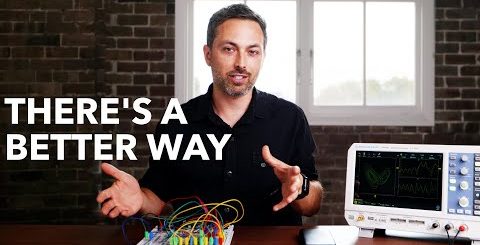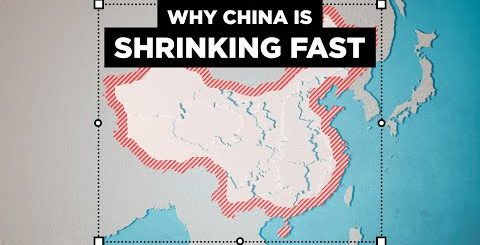Why Railroads Don’t Need Expansion Joints
A friendly overview of thermal effects on railways.
💡 Go to https://brilliant.org/PracticalEngineering for a 30-day free trial & the first 200 people will get 20% off their annual subscription.
🚆 Watch the entire railway series here: https://youtube.com/playlist?list=PLTZM4MrZKfW-DUovVfoD_EfOwXTY1Zog5&si=Wc3am9N14wuNou16
Errata: At 9:00, the left column of calculations is incorrectly labeled “SI.” It should be imperial. Whoops!
Just as all materials have a mostly linear relationship between temperature change and length change, all materials also have a similar relationship between stress and change in length (often called strain). And this is part of the secret to continuous welded rail: restrained thermal expansion. You can overcome one with the other.
Watch this video ad-free on Nebula: https://nebula.tv/videos/practical-engineering-why-railroads-dont-need-expansion-joints
Signed copies of my book (plus other cool stuff) are available here: https://store.practical.engineering/
Practical Engineering is a YouTube channel about infrastructure and the human-made world around us. It is hosted, written, and produced by Grady Hillhouse. We have new videos posted regularly, so please subscribe for updates. If you enjoyed the video, hit that ‘like’ button, give us a comment, or watch another of our videos!
CONNECT WITH ME
____________________________________
Website: http://practical.engineering
Twitter: https://twitter.com/HillhouseGrady
Instagram: https://www.instagram.com/practicalengineering
Reddit: https://www.reddit.com/r/PracticalEngineering
Facebook: https://www.facebook.com/PracticalEngineerGrady
Patreon: http://patreon.com/PracticalEngineering
SPONSORSHIP INQUIRIES
____________________________________
Please email my agent at practicalengineering@standard.tv
DISCLAIMER
____________________________________
This is not engineering advice. Everything here is for informational and entertainment purposes only. Contact an engineer licensed to practice in your area if you need professional advice or services. All non-licensed clips used for fair use commentary, criticism, and educational purposes.
SPECIAL THANKS
____________________________________
This video is sponsored by Brilliant.
Stock video and imagery provided by Getty Images, Shutterstock, and Videoblocks.
Music by Epidemic Sound: http://epidemicsound.com/creator
Tonic and Energy by Elexive is licensed under a Creative Commons Attribution License
Source: https://www.youtube.com/watch?v=U6fBPdu8w9U
Video by Grady Hillhouse
Edited by Wesley Crump
Produced by Ralph Crewe
Graphics by Nebula Studios








Awesome! I’ve seen thermite rail welding before and was curious behind the why’s of it.
Used to do thermite welds. Works on 2″ gaps, its basically adding molten metel between 2 pieces of hot metal. Usually the thermite burns at 1400° F
Love watching thermite welding.
@@NavajoNinjabasically volumetric welding?
woah, cool seeing you here. I subscribed to you many years ago, I hope you’re well.
As a civil engineer, this type of content is therapy
your quite the nerd
And that’s a great thing.
I watched about half of it until I got bored and clicked away
I’m an electrical engineer and I find this therapy also.
I’m a software engineer and I find this therapy also
Railway engineer here! A few points:
Not all rail is made of the same alloys, particularly high load areas such as points and crossings. These use harder metals to reduce wear, such as manganese. Adding this into the equation means welding plain line to p&c is a particularly complex job.
I am also glad you mentioned track circuit will be covered later on as that is a big downside to CWR with older signalling systems.
Aluminothermic welding is spectacular when it goes wrong, search it up!
So let me ask a question what I wondered about often. So the pictures of buckling rail is because those rails were not installed properly? For example laid in cold winter without heating or applying pre-tension? And/or were the ties in the past worse in keeping the rail straight?
Is it common for rail to be heated/tensioned in mild climates when a new track is built or does this only happen in more extreme climates like Texas?
@@whuzzzup if installing CWR most of it needs to be installed and stretched to the length at the stress free temperature rail length. I.e in the UK all tensioned rail is stretched to it’s equivalent length at around 27 Celsius.
It’s also important to note that this is the rail temperature not air temperature so it may not be very warm but if it is a sunny day the rail will become a lot hotter than air temp. This is when buckling occurs as the rail becomes very hot and has nowhere to move. Majority of this happens when a vehicle is running over the rail.
As engineers know this we implement critical rail temperatures to ensure that beyond a certain temperature we know the rail is expanding we can gradually implement speed restrictions etc. to reduce these risks to public.
I can see diagonal tapers being used in between blocks to isolate block signals from each other.
@@thomaswalters4365Those are expansion joints. I am as yet to see one used in that application.
Hi Sam, I was a railway engineer too back in the days of BR, worked out of Derby Research. I missed the part where he mentioned track circuits, but I am very interested to see the American slant on it.
If anyone wonders why the odd figure of 39 feet was the standard length of single sticks of traditional jointed rail, it was so that they’d fit into 40-foot gondola cars. Welded rail is now typically manufactured in long lengths (1,320 feet in the USA, which is ¼ mile) and can be welded in the field to be continuous. Such long rails are transported on special rail trains, like the one Grady shows half-loaded at 0:25. The yellow racks hold them in place, and the rails bend as the train goes through horizontal and vertical curves 😮.
Actually the modern rails are rolled in about 30-meter lengths and then welded into the quarter-mile lengths to be transported to the laying site and then welded by a portable electric welding machine or thermite welding process in track.
@@royreynolds108 The fabricating of quarter-mile lengths is part of the manufacturing process. I intentionally avoided saying that the rails were rolled that long.
The rails are only “held in place” in the middle. They lay on the rest of the structures.
@@ferky123 True that they’re fastened down only at the middle, but the racks surround them to keep them aboard and untangled, to guide them to bend around curves, etc.
Didn’t know that about the 39′.
Makes a lot of sense.
Had to transport the rail to the site somehow back then. Gons were 40 foot.
As a engineer who works in railway track design, one thing I’d like to point out – especially since you mentioned a video on signaling will be coming soon – is that neutral temperature is typically high not because a broken rail is less dangerous than a sun kink. Yes, its more likely that a train could operate over a pull-apart rather than theough a sun kink, but largely because the signal system will detect a pull-apart as a discontinuity in the rails and thus the signal circuit – automatically turning the signal ahead of that track to red!
I’ve always been amazed at how railroads developed signalling systems. And how the idea of ‘fail-safe’ design was involved waaaayyyy back in the early 20th century. Broken rails, loss of power, relay failures were all considered and will set signalling ‘safe’.
ooooooooooooh, right, cause if you use disjointed rail you have to have a separate cable for the signal to travel on, at least in every joint. so even if pointy joins solved the expansion issue the added wires and cases and little welds sounds like a lot of extra work.
Im interested to know how that works. Im pretty sure I saw bare copper used as grounding for the rails last time I paid attention to it. Or have I missed something
@@Tupsuu It depends a lot of the specific railway line, that could have been traction power return cables, grounding, equalizers between adjacent tracks, signal infrastructure, etc…
@@mikefochtman7164 That fail safe system was paid for in blood though. But since rail is that old most of the accidents aren’t that highly publicized or live in recent memory like development of the airplane and space flight.
It is kind of interesting to see how safety culture around cars is so low, but that is I think a question of high amount of owner operators/low barrier to entry. On rail most things are owned by large corps, which has similarities to aerospace as well.
Fun fact: The problem with ‘rock n’ roll’ (more formally, harmonic rocking) is bad enough that rulebooks disallow travelling at certain speeds on jointed rail. The rulebook I have says this danger zone is 13 to 21 mph, so if your train only has enough power to reach 20 mph (entirely possible, if normal, these days) safety says you’d have to slow to 13 mph on jointed rail. So CWR not only makes maintenance-of-way’s job easier, it also makes operating the trains a bit easier and safer too.
r e s o n a n c e
@@erich1394 I think you both are correct. As a civil engineer who spent over 20 years in track design and work, the term “harmonic rocking” is the one used by the railroads with certain speeds over jointed track with alternating low joints. It is the alternating low joints that cause the problem not the joints by themselves. There was a lot of research done to determine this phenomina.
So I think your point is; stay out of the resonance zone or transient through it as quickly as possible. Go slower or faster so you don’t build up a resonance that can, not always but can go exponential. Blown mind all these little details that add up.
@@royreynolds108 Also bogey (or track) hunting. I forget which car type, one had a both a lower and upper speed limit when unloaded due to excessive gauge resonance that lead to $many derailments.
“Stress is what breaks things” is a truth that more people should apply to their own lives
Well said.
Much truth
I developed a broken rail detection system at San Francisco BART that used ultrasonic waves traveling miles in the continuously welded rail. As part of characterizing the rail I measured acoustic properties as a function of rail temperature. It was amazing to see the rail temperature exceed 140 degrees F on medium hot days, like air temperature in the 90’s. The peak temperature was in the late afternoon when the rail web caught most of the sunlight. Definitely painful to touch!
“Don’t touch the 3rd rail, it’s hot.”
“What do you mean? They’re ALL hot!”
I love that the primary solution for buckling is just “do it on a really hot day lol.” It’s the kind of thing that sounds way too dumb to work but is somehow the most genius solution ever.
My man, promoting math to the masses. We need more folks like you!